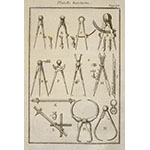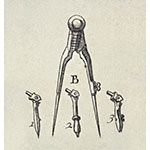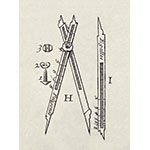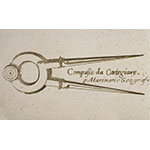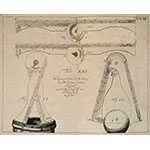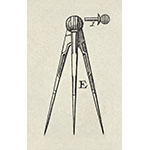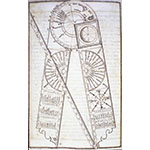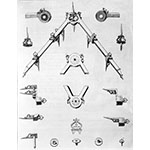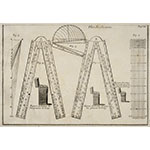Instruments consisting of two legs of equal length hinged together to allow their positioning at a desired angle. In their different configurations, compasses are used for a variety of operations such as drawing, calculating proportions, measuring calibers, and determining positions at sea.
Compasses with fixed points used in architectural design and construction work to record measurements and divide lines into equal parts. There is a simple model and a model with a micrometer screw for greater precision in the leg aperture. They are the type of compasses generally depicted in scientific iconography, together with the square and plumb level, as symbols of geometry.
Compass with intersecting legs and a fixed or movable center, whose opposite points form simple ratios of 1:2, 1:3, etc. The instrument's main purpose is to reproduce drawings at smaller or larger scales.
The simplest type of nautical compasses, known as single-handed dividers, has fixed points that can be used with a single hand, for plotting courses and distances on sea charts while navigating.
More complex are the nautical compasses of Robert Dudley (1573-1649), who served for many years with the Medici and supervised the fortifications of the port of Leghorn. Fitted with flat legs and sights, they were used for various kinds of measurements during navigation.
Composed of two curved legs tapered to a point, these compasses are designed to measure the diameters of spherical and cylindrical bodies (thickness compasses) and the width of cavities (caliper compasses). In military use, they serve to measure gun calibers and shot diameters. In architecture, they are used to measure and build columns. In sculpture, they also serve to transfer the measurements from the model to the work in progress. Spherical compasses are often fitted with a graduated arc that provides a direct read-out of the measurement.
Three-legged compasses, also called spherical compasses or globe compasses, served to transfer onto a map the positions of places taken on a globe, by measuring the distances between three points. Also used to reproduce drawings or maps to scale.
Instruments typically consisting of two graduated flat legs, fitted with sights at both ends and a magnetic compass with a degree scale at the hinge. Were designed to measure position angles and distances in surveying work. Sometimes, as with the archimetro, the compass had a cross-arm hinged to a cursor sliding on one of the legs. This accessory made it possible to measure the distance between two remote points.
Special eight-point proportional compasses, invented by da Mordente (1532-c. 1608), featuring cursors whose tips were orthogonal to the leg axes. The position of the tips, measured by means of a rule engraved with proportional scales, was used to define proportions between lines, geometrical figures, and solid bodies. These compasses were also used for surveying.
Compasses whose legs carry proportional scales that serve to define proportions between lines, geometrical figures, solid bodies, and so on. Federico Commandino (1509-1575) and Jost Bürgi (1552-c. 1632) developed a cross-legs model resembling the reduction compass. There is also a flat-legs version, perfected by Galileo (1564-1642) in his geometric and military compass.








